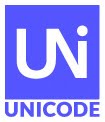
The cover for Version 11.0 is an original design by Joyce S. Lee, a graduate student in the UC Berkeley School of Information. Her artwork was inspired by the well-known early 20th-century Bauhaus design school. She explains, “I see numerous parallels between the Bauhaus and the Unicode Consortium, including an intersection of workmanship and technological reproduction, a spirit of collaboration, as well as a widespread cultural influence. With this Bauhaus inspired cover, I thus aim to represent the Unicode Standard as a form of instructional reference for technologists around the world.”
![[cover art by Monica Tang]](https://cdn.statically.io/img/lh3.googleusercontent.com/blogger_img_proxy/AEn0k_ue4e4cCHVHgcxHRLi9KP7I9Jc1vasbZUi__rqAgS31ORQivkg8mT16mWqugmqn6OByQgvGYWM4G__55ApUIwWkaI2uGjahAaNnVd-QJ7Vowq1KAmEIpv-cOxAau9ToQ6RB=s0-d)
Cover artwork for Version 12.0 was created by Monica Tang, a computer science student at UC Berkeley. Her design was inspired by the simplicity of the geometric shapes that comprise the diversity of characters and symbols represented in the Unicode Standard. She notes, “Incorporating a variety of shapes and colors into a patterned design, I seek to convey the sheer breadth of the languages covered in the Unicode Standard as well as a sense of commonality.”
Runner-up designs by Feixiong “Hasutai” Liu and Maurice Meilleur were also selected. Hasutai is the founder and chief designer of Sir Sebsihiyan Sibe-Manchu Culture Center. Maurice Meilleur is Assistant Professor of Graphic Design at Appalachian State University.
Hasutai:
![[art by Hasutai]](https://cdn.statically.io/img/lh3.googleusercontent.com/blogger_img_proxy/AEn0k_uhAHj3tFsGY7Lfv5OWY1M822la1NEgDUPzUcdRNHXf904_gQQfmk0p56RUQb_4hllTiL641XDkgtpASfUmtjXcYO_nm7u9B2t0hQAAv3Nl9aCipNj9jIavr6rQtcFEQFk=s0-d)
Maurice Meilleur:
![[art by Maurice Meilleur]](https://cdn.statically.io/img/lh3.googleusercontent.com/blogger_img_proxy/AEn0k_u8u7e9PEqCjo5if4-1l1Kn7YUJT9XJ7H-TsWX0uODQEfXREm0-hovVORk8xRVt9JWmhNacwK7Q7NY040XIG0AQO-e8-p1sHc-xL6D-vwK1Nqj_r_Pb358JykU8Md4yfW7S=s0-d)
Adopt-a-Character
Over 130,000 characters are available for adoption, to
help the Unicode Consortium’s work on digitally disadvantaged languages.
![[badge]](https://cdn.statically.io/img/lh3.googleusercontent.com/blogger_img_proxy/AEn0k_uWKXC6GlSsT8BIdtcI5PYRkNOVD9ml8TYQ6mja8aoAVTV6JEnYUIwEF4Y-xgQZWW5wXHDViSOQ_mzNA0HjSH_2Yf_82kBefu2Hn6WpL_-1-IVy3UMDAXsa=s0-d)
![[badge]](https://cdn.statically.io/img/lh3.googleusercontent.com/blogger_img_proxy/AEn0k_uWKXC6GlSsT8BIdtcI5PYRkNOVD9ml8TYQ6mja8aoAVTV6JEnYUIwEF4Y-xgQZWW5wXHDViSOQ_mzNA0HjSH_2Yf_82kBefu2Hn6WpL_-1-IVy3UMDAXsa=s0-d)

 Version 11.0 of the Unicode Standard is now available, both the core
specification and data files. Version 11.0 adds 684 characters, for
a total of 137,374 characters. These additions include seven new
scripts, for a total of 146 scripts, as well as 145 new emoji.
Version 11.0 of the Unicode Standard is now available, both the core
specification and data files. Version 11.0 adds 684 characters, for
a total of 137,374 characters. These additions include seven new
scripts, for a total of 146 scripts, as well as 145 new emoji.![[emoji image]](https://cdn.statically.io/img/lh3.googleusercontent.com/blogger_img_proxy/AEn0k_s8uCzTwMCGFGnbv6maw8J09Lrs3RH2lbI-s1isv9Cvpd-HyxW5OY6jHnQIJXlFDkPEGDdFABDjKAWQ6K-9LnuzNnBC8j0F22a3jTWmQqhnaIWFtWdPlNL1Jak_Ok0=s0-d)
 The beta review period for Unicode 11.0 has started. The Unicode Standard is the foundation for all modern software and communications around the world, including all modern operating systems, browsers, laptops, and smart phones—plus the Internet and Web (URLs, HTML, XML, CSS, JSON, etc.). The Unicode Standard, its associated standards, and data form the foundation for CLDR and ICU releases. Thus it is important to ensure a smooth transition to each new version of the standard.
The beta review period for Unicode 11.0 has started. The Unicode Standard is the foundation for all modern software and communications around the world, including all modern operating systems, browsers, laptops, and smart phones—plus the Internet and Web (URLs, HTML, XML, CSS, JSON, etc.). The Unicode Standard, its associated standards, and data form the foundation for CLDR and ICU releases. Thus it is important to ensure a smooth transition to each new version of the standard.

